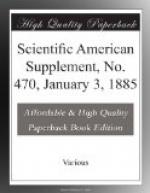Hypogallic acid, C_{16}H_{30}O_{2}, combines with 100.00 grammes. iodine.
Oleic acid, C_{18}H_{34}O_{2} " " 90.07 " "
Erucic acid, C_{22}H_{42}O_{2} " " 75.15 " "
Ricinoleic acid, C_{18}H_{34}O_{3} " " 85.24 " "
Linoleic acid, C_{16}H_{28}O_{2} " " 201.59 " "
Of the halogens employed in the examination, iodine is preferable to either chlorine or bromine; it acts but slowly at ordinary, but energetically at elevated temperatures. The reagents are solution of mercury iodo-chloride prepared by dissolving of 25 grms. iodine, 500 c.c. alcohol of 95 per cent., and of 30 grms. mercury chloride in an equal measure of the same solvent; both liquids are filtered and united; a standard solution of sodium hyposulphite produced by digestion of 24 grms. of the dry salt with 1 liter water and titration with iodine solution; solution of potassium iodide of 1:10; chloroform, and finally a solution of starch. The above solution of mercury iodo-chloride acts on both free unsaturated acids and glycerides, producing addition products. For testing a sample of 0.2 to 0.4 grm. of a liquid, and from 0.8 to 1.0 grm. of a solid fat being used, which is dissolved in 10 c.c. chloroform and treated with 20 c.c. mercury iodo-chloride solution run into it from a burette, if the liquid appear opalescent a further measure of chloroform is introduced, while the amount of mercury iodo-chloride must be such as to produce a brownish coloration of the chloroform for two subsequent hours. The excess of iodine is determined, on addition of from 10 to 15 c.c. potassium iodide solution and 150 c.c. distilled water, by means of caustic soda. From a burette divided into 0.1 c.c. a solution of caustic soda is poured with continual gyration of the flask into the tinged liquid, and the percentage of combined iodine ascertained by difference; for this purpose 20 c.c. of mercury iodo-chloride are tested, on introduction of a solution of potassium iodide and starch, previously to its use as reagent. Adulteration of solid or semi-liquid fats, especially lard, butter, and tallow, with vegetable oils are readily detected by this method, since the latter yield on examination a high percentage of iodine. Animal fats, absorb comparatively less halogen than vegetable fats, and the power to combine with iodine increases with the transition from the solid to the liquid state, and attains its maximum with vegetable oils—the method being adapted to the examination of fat mixtures containing glycerides and free saturated fatty acids, provided that substances which under similar conditions combine with iodine are absent. These conditions are fulfilled with regard to the examination of animal fats and soap. Ethereal oils are also acted upon by iodine; the reaction proceeds similar to that observed in ordinary fat mixtures. Alcoholic mercury iodo-chloride can probably be used with success in synthetical chemistry, as it allows determination of the free affinities of the molecule and conversion of unsaturated compounds into saturated chlorine-iodo addition products.—Rundschau.




